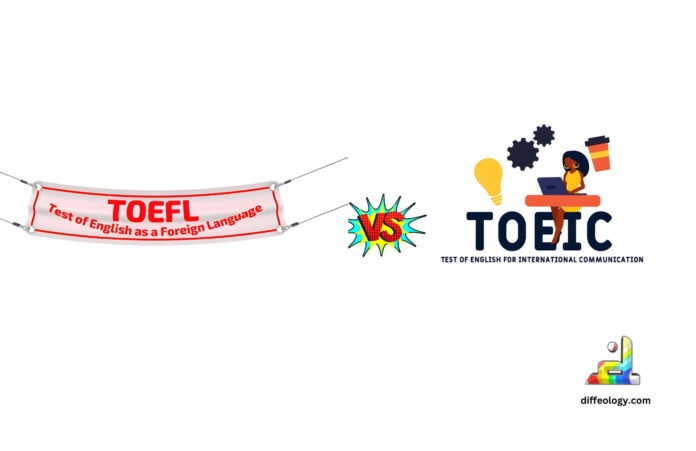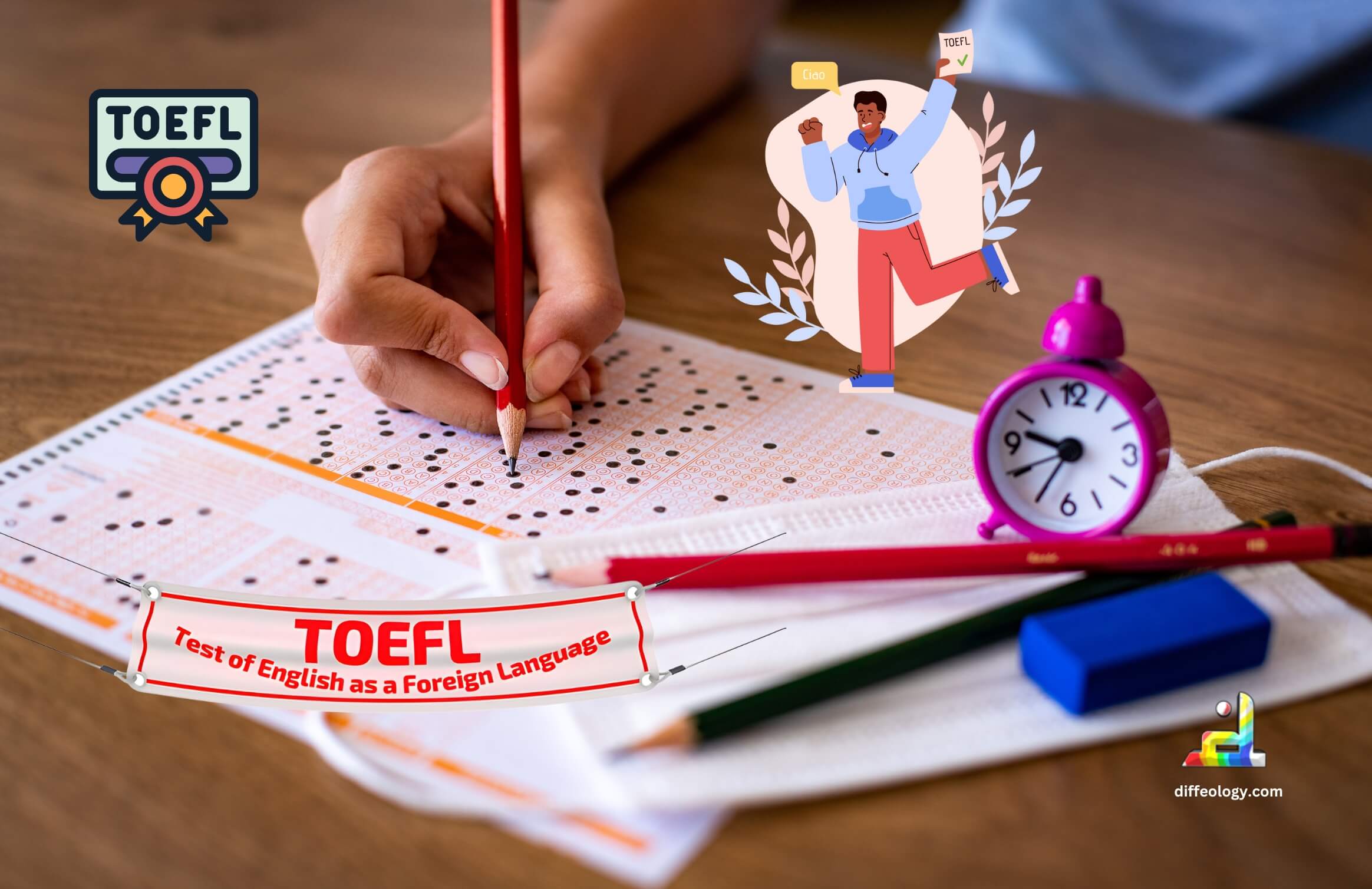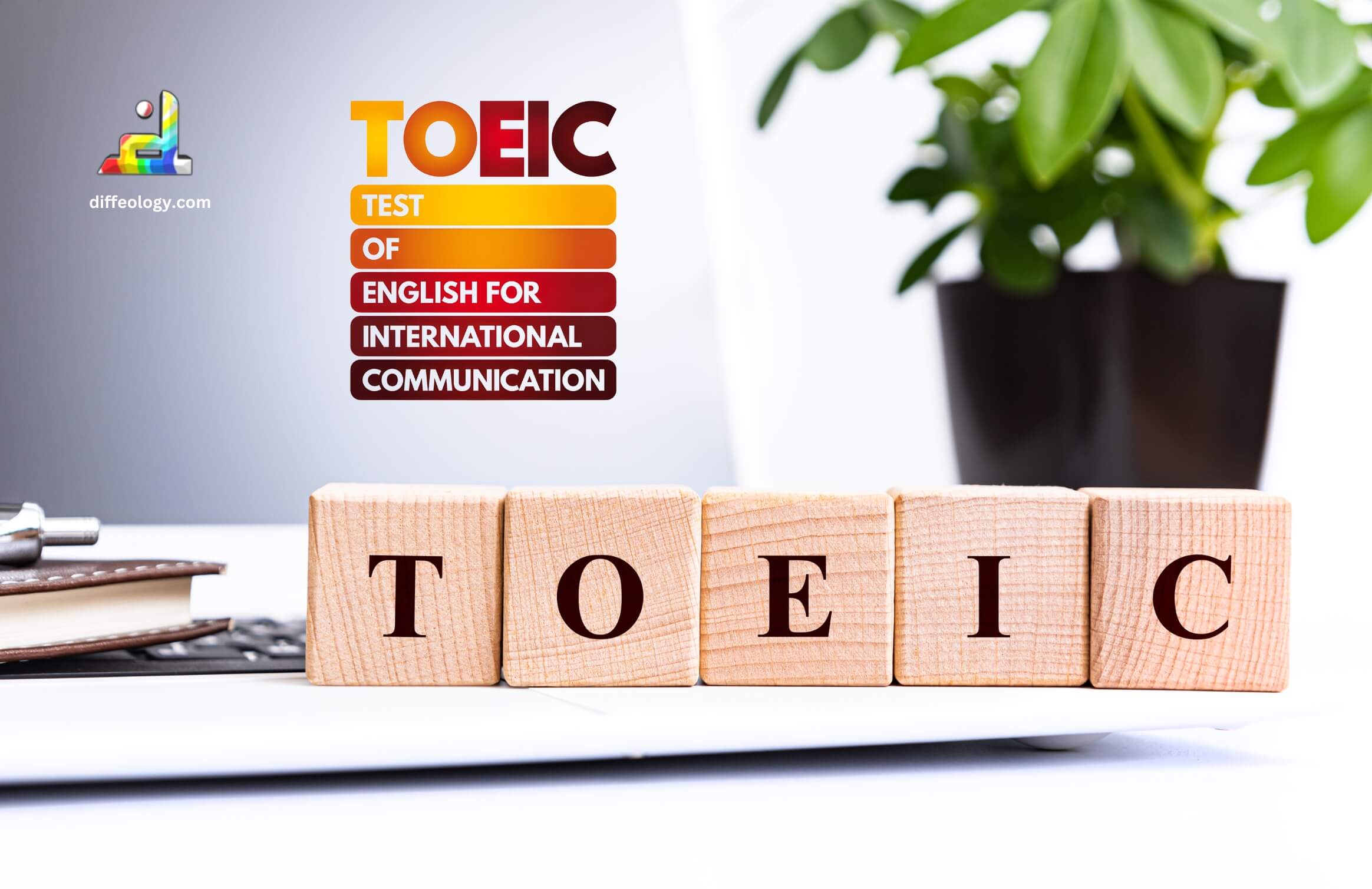The TOEFL (Test of English as a Foreign Language) and TOEIC (Test of English for International Communication) are two prominent exams designed to assess English proficiency, but they serve different purposes. TOEFL focuses on academic English skills necessary for university admissions and scholarships globally, comprising four sections: Reading, Listening, Speaking, and Writing. In contrast, TOEIC evaluates English proficiency in a workplace context, emphasizing practical communication skills needed in international business environments. TOEFL is widely accepted by universities in English-speaking countries, with over 11,000 institutions recognizing it, while TOEIC is utilized by corporations and organizations to gauge the English proficiency of employees and job applicants. Understanding the Difference between TOEFL and TOEIC can help individuals choose the test that aligns best with their academic or career goals.
Main Difference Between TOEFL and TOEIC
TOEFL is mainly used to measure academic English skills for university admissions, while TOEIC is designed to assess English proficiency in a workplace setting. TOEFL is offered at test centers worldwide. TOEIC is available at numerous test centers, often in partnership with corporations and educational institutions. TOEFL scores are often required for student visa applications in English-speaking countries. TOEIC scores can be used for certain work visas and professional credentials. TOEFL speaking tasks are recorded and evaluated by human raters. TOEIC speaking tasks involve responding to prompts via a computer, also evaluated by human raters. TOEFL writing tasks include essays and responses to reading/listening tasks. TOEIC writing tasks involve writing emails and opinion essays relevant to business. TOEFL listening includes academic lectures and conversations. TOEIC listening focuses on business-related dialogues, announcements, and conversations.
TOEFL Vs. TOEIC
What is TOEFL
The TOEFL, or Test of English as a Foreign Language, is a standardized test designed to assess the English language proficiency of non-native speakers. It’s widely recognized by universities, colleges, and agencies around the world as a measure of one’s ability to understand and use English in an academic setting. Here’s a breakdown of what TOEFL entails:
Test Structure: The TOEFL iBT (Internet-based Test) consists of four sections: Reading, Listening, Speaking, and Writing. Each section evaluates different language skills. For example, the Reading section assesses your ability to understand academic texts, while the Speaking section measures your ability to communicate effectively in English.
Read Also: Difference Between Lye and Lie
TOEFL scores range from 0 to 120, with each section scored separately. Universities often set their own minimum score requirements for admission. Additionally, the test provides MyBest scores, which combine your best scores from each section across multiple test dates, allowing you to showcase your highest achievements. People take the TOEFL for various reasons, including applying to universities, scholarship programs, and visa applications. It’s essential for international students planning to study in English-speaking countries like the United States, Canada, and Australia. Test preparation typically involves studying English grammar and vocabulary, and practicing test-taking strategies. Many resources, including practice tests and study guides, are available to help candidates achieve their target scores.
What is TOEIC
The TOEIC, or Test of English for International Communication, is a globally recognized standardized test that assesses English language proficiency in everyday work and international business settings. It measures both listening and reading skills, focusing on how well individuals can understand English as used in various professional contexts. Test Structure: The TOEIC consists of two main sections: Listening and Reading. The Listening section evaluates a test-taker’s ability to understand spoken English through a series of recorded conversations and lectures. The Reading section assesses comprehension of written English, including texts commonly found in work environments.
Read Also: Difference Between Fact and Opinion
Scores on the TOEIC range from 10 to 990 points, providing employers and institutions with a clear measure of an individual’s English proficiency. Many corporations and organizations use TOEIC scores to make decisions about hiring, promotions, and training programs, as it helps gauge how well employees or potential candidates can communicate in an international business setting. Preparation for the TOEIC typically involves practice tests and study materials aimed at improving listening and reading skills in business-related contexts. Achieving a high TOEIC score can enhance career prospects and demonstrate language proficiency for those seeking opportunities in multinational companies or planning to work or study abroad.
Comparison Table “TOEFL Vs. TOEIC”
| Purpose | Academic English skills | Workplace English skills |
| Focus | Reading, writing, speaking, listening | Listening and reading |
| Audience | Students | Professionals |
| Usage | University admissions | Job applications |
| Duration | About 4 hours | About 2 hours |
| Sections | 4 | 2 |
| Speaking Test | Yes | Optional |
| Writing Test | Yes | Optional |
| Listening | Academic lectures, conversations | Business conversations, announcements |
| Reading | Academic texts | Business documents |
| Test Format | Internet-based (iBT) | Paper-based |
| Score Range | 0-120 | 10-990 |
| Scoring Method | Composite score from 4 sections | Separate scores for listening and reading |
| Test Frequency | 50 times a year | Multiple times a year |
| Acceptance | Universities worldwide | Companies worldwide |
| Preparation Time | Several months | Few weeks to months |
| Cost | Higher | Lower |
Difference Between TOEFL and TOEIC in Detail
Let’s know the Difference between TOEFL vs TOEIC in detail.
Purpose and Use
The TOEFL (Test of English as a Foreign Language) and the TOEIC (Test of English for International Communication) serve different purposes. TOEFL is designed to assess the academic English skills of students who want to study at English-speaking universities. It focuses on language used in a classroom setting, including lectures, textbooks, and academic discussions.
On the other hand, TOEIC measures the English proficiency of individuals who want to use English in a professional workplace environment. It evaluates how well someone can communicate in business settings, including meetings, emails, and presentations. Companies often use TOEIC scores to make decisions about hiring, promotions, and training.
Test Structure and Content
The TOEFL iBT test is divided into four sections: Reading, Listening, Speaking, and Writing. Each section assesses specific academic skills. The Reading section includes passages from university-level textbooks. The Listening section includes lectures and discussions. The Speaking section requires test-takers to respond to academic prompts. The Writing section involves writing essays based on reading and listening tasks.
The TOEIC test, on the other hand, primarily focuses on Listening and Reading. It consists of multiple-choice questions that assess everyday work situations. There are also optional Speaking and Writing tests that evaluate more specific communication skills, such as giving presentations and writing emails. The TOEIC Listening and Reading test lasts about two hours, whereas the Speaking and Writing tests are shorter.
Scoring Systems
The scoring systems for TOEFL and TOEIC are different. The TOEFL iBT test scores range from 0 to 120. Each of the four sections is scored on a scale of 0 to 30, and the total score is the sum of the scores from all sections.
TOEIC scores range from 10 to 990. The Listening and Reading sections each have a score range of 5 to 495, which are then combined to get the total score. The optional Speaking and Writing tests are scored separately on a scale of 0 to 200. Different organizations set their own score requirements based on what level of English proficiency they need.
Acceptance and Recognition
TOEFL is widely accepted by universities and colleges in English-speaking countries. Over 11,000 institutions in more than 150 countries accept TOEFL scores for admission purposes. It is especially popular in the United States, Canada, Australia, and the United Kingdom.
TOEIC is recognized by many companies and organizations worldwide. More than 14,000 organizations across 160 countries use TOEIC scores for hiring, training, and promotion decisions. It is particularly popular in Asia, including countries like Japan and South Korea, where English proficiency is crucial for business and professional success.
Test Availability and Frequency
The TOEFL iBT test is available in over 4,500 test centers around the world. It is offered more than 50 times a year, giving test-takers plenty of opportunities to schedule their exams. Registration can be done online, and there are various preparation materials available to help students get ready for the test.
TOEIC tests are also widely available, with numerous test centers in many countries. The Listening and Reading tests can be taken multiple times a year, while the Speaking and Writing tests are offered less frequently. Some organizations arrange private test sessions for their employees, making it convenient for candidates to take the test when needed.
Preparation Resources
There are various resources available for both TOEFL and TOEIC preparation. For TOEFL, students can use official practice tests, study guides, and online courses provided by ETS, the organization that administers the test. There are also many third-party books and online resources that offer practice questions, test-taking strategies, and tips.
For TOEIC, ETS provides official preparation materials, including practice tests and study guides. Additionally, many language schools and online platforms offer TOEIC preparation courses and practice exercises. These resources help test-takers familiarize themselves with the test format and improve their skills in listening, reading, speaking, and writing/
Skills Assessed
The TOEFL test is designed to evaluate the four primary language skills needed for academic success: Reading, Listening, Speaking, and Writing. Each section tests specific abilities. For example, the Reading section includes passages from university-level textbooks and asks questions about them. The Listening section includes lectures and classroom discussions. The Speaking section asks test-takers to respond to academic prompts, and the Writing section requires essays based on reading and listening tasks.
TOEIC, on the other hand, focuses on English skills used in a professional environment. The test primarily includes Listening and Reading sections, with optional Speaking and Writing tests. These sections assess practical communication skills used in business settings, such as understanding meetings, phone conversations, and written communications like emails and reports.
Duration and Format
The TOEFL iBT test takes about four hours to complete. The test is structured to measure comprehensive language skills through a combination of multiple-choice questions, spoken responses, and written essays. Each section is timed, and test-takers must complete tasks within the allotted time.
In contrast, the TOEIC Listening and Reading test lasts about two hours, consisting of 100 questions for each section. The Speaking and Writing tests are shorter, each taking about 20 minutes to complete. The TOEIC test uses a multiple-choice format for Listening and Reading while Speaking and Writing involve recorded responses and written tasks,
Test-Taker Demographics
The TOEFL test is primarily taken by students who want to study at English-speaking universities. Most test-takers are non-native English speakers from various countries who need to prove their academic English proficiency to gain admission to undergraduate or graduate programs. The test is popular among students aiming to study in the United States, Canada, the UK, and Australia.
TOEIC test-takers typically include professionals who need to demonstrate their English language skills for their jobs. This group includes employees of international companies, job seekers, and individuals looking to improve their career prospects. TOEIC is especially popular in countries like Japan and South Korea, where English proficiency is a significant advantage in the job market.
Key Difference Between TOEFL and TOEIC
- Target Audience: TOEFL is for students who want to study at universities where English is the medium of instruction. TOEIC is for professionals looking to prove their English skills in a business environment.
- Skills Tested: TOEFL evaluates reading, listening, speaking, and writing skills in an academic context. TOEIC focuses on listening and reading comprehension in a business context, with optional speaking and writing tests.
- Test Format: TOEFL is generally taken on a computer and consists of four sections: reading, listening, speaking, and writing. TOEIC is typically a paper-based test with listening and reading sections, though computer-based options are available for speaking and writing.
- Scoring System: TOEFL scores range from 0 to 120, combining all four sections. TOEIC scores range from 10 to 990, combining listening and reading scores, with separate scoring for speaking and writing if taken.
- Test Duration: TOEFL takes about four hours to complete. The TOEIC listening and reading test lasts about two hours while speaking and writing tests add approximately another 90 minutes.
- Content Focus: TOEFL includes academic texts and lecture-based questions. TOEIC features workplace scenarios, emails, and conversations relevant to business.
- Global Recognition: TOEFL is widely accepted by universities and educational institutions worldwide. TOEIC is recognized by many corporations and government agencies for employment purposes.
- Preparation Materials: TOEFL preparation often involves academic study guides and practice tests. TOEIC preparation focuses on business English and practical workplace scenarios.
- Cost: The cost of taking TOEFL varies by country but is generally higher than the TOEIC test. TOEIC fees can also vary, especially if taking optional speaking and writing sections.
- Frequency of Test Availability: TOEFL is offered around 50 times a year at authorized test centers. TOEIC tests are available on multiple dates throughout the year, often with more flexible scheduling.
FAQs: TOEFL Vs. TOEIC
Conclusion:
The TOEFL and TOEIC tests are both used to measure English proficiency, but they serve different purposes. TOEFL focuses on academic skills needed for university studies, covering reading, listening, speaking, and writing, with scores ranging from 0 to 120. In contrast, TOEIC assesses practical English skills necessary for global workplaces, testing listening and reading abilities, with scores ranging from 10 to 990. In summary, TOEFL prepares students for university-level English, while TOEIC helps professionals demonstrate their English proficiency in international business contexts.
References & External Links
- Everything You Need to Know About TOEFL: What Is It and How to Prepare
- TOEIC Overview



